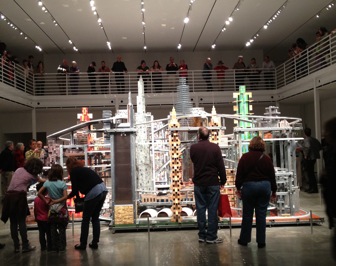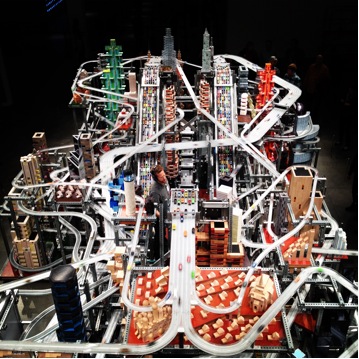Even though I'm a professional planner and am familiar with the gritty details, I find model cities appealing because they allow me to examine a city from angles and perspectives not possible in real life. The idea of building a city comprehensively from scratch is exciting, especially when compared to the incremental, piecemeal, and fragmented approach to planning most of us have grown accustomed to. This sort of fantasy is on full display in Metropolis II, a dynamic kinetic sculpture by artist Chris Burden, currently showing at the Los Angeles County Museum of Art.
Metropolis II features miniature cars that race through the city at 240 scale miles per hour; this means that every hour, the equivalent of about 100,000 cars circulate through the dense network of buildings. Steel beams form an eclectic grid interwoven with a complex system of 18 roadways, including a six-lane freeway and train tracks. Not only is this sculpture a sight to see, it also features the noise of the zooming cars efficiently captures and communicates the busyness and sometimes craziness of city living. In Burden's words, "The noise, the continuous flow of the trains, and the speeding toy cars, produces in the viewer the stress of living in a dynamic, active and bustling 21st Century city." Traditional architectural models of future projects or even the impressive models of major cities at Legoland are static, and lack the energy and vibrancy generated by Burden's piece. He suggests that motion is as much a part of a city as form is.

As a park planner, I was initially disappointed that Metropolis II does not include any parks or open space. Although the piece could represent a variety of cities and not just Los Angeles, I even thought Burden could have made the point that Los Angeles is one of the most park-poor cities in the country with Metropolis II. In fact, Burden represents nature by the use of different colored panels that the buildings rest on. Thus, while abstract, the green, brown, or light tan panels may be perceived as the parks, open spaces, or recreational areas that contribute to the vitality of any city. Abstract though it may be, this sort of representation suggests, rightfully, that open space is a crucial part of any city, even if buildings and vehicles seem more exciting.
While I spent much time marveling at the wide variety of buildings, Metropolis II is actually more about transportation and mobility than architecture. It is a representation of Burden's dream of a future city where cars can go faster and are completely automated, as envisioned by projects such as Google's driverless car project. The buildings were only put in after the car-racing tracks had been installed and the entire kinetic sculpture was operational.
The process and approach Burden took to create Metropolis II is refreshing and admirable because he was able to consider the city in its entirety. Unfortunately, planning in reality has become fragmented, with planners specializing in particular fields (like transportation, land use, parks) and not necessarily working collaboratively due to bureaucratic and other factors.
Two of the biggest ongoing challenges for us planners are communicating clearly with the public and maintaining interest on important planning issues. Obviously, through Metropolis II Chris Burden has achieved both, as evidenced by the great turnouts at LACMA and the extensive media coverage. Part of the appeal of Metropolis II can certainly be attributed to Burden's reputation as the well-known artist who created installations like Urban Light (which is displayed at the entrance to LACMA).
Nevertheless, this does not mean that planners cannot attract or engage large crowds at urban planning events without Burden's participation. On the contrary, the popularity of Metropolis II should challenge all of us to rethink current practices and pursue innovative ways to involve community members in planning. For example, James Rojas' interactive planning approach through the use of model building has proven successful in engaging the public and encouraging creative city-making. Having participated in a Rojas-led exercise before, I understand firsthand how this approach empowers participants by allowing them to shape and share visions in a supportive environment without the fear of providing a "wrong" answer.
Clement Lau is a planner with the L.A. County Department of Parks. Photos by Julie Yom.




